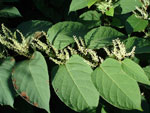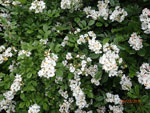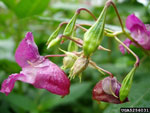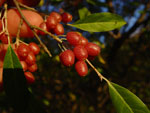DACF Home → Bureaus & Programs → Maine Natural Areas Program → Communities, Plants, and Animals → Invasive Plants
Invasive Plants
An invasive plant is defined as a plant that is not native to a particular ecosystem, whose introduction does or is likely to cause economic or environmental harm or harm to human health. Those plants that are not native, only a small fraction are considered invasive, but these have the potential to cause great harm to our landscape.
Popular Resources: Photo Gallery / Advisory List / Do Not Sell List
On this Page:
What is an invasive plant?
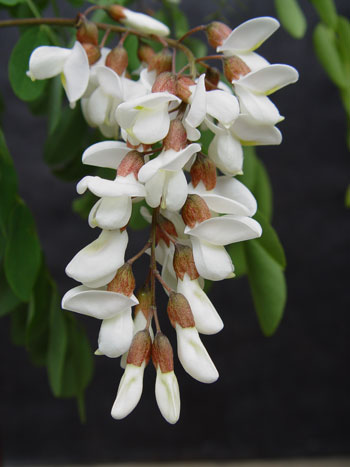
Black locust flowers
An invasive plant is defined as a plant that is not native to a particular ecosystem, whose introduction does or is likely to cause economic or environmental harm or harm to human health. There are currently approximately 2,100 plant species recorded from Maine. Approximately one third of those are not native. Of those plants that are not native, only a small fraction are considered invasive, but these have the potential to cause great harm to our landscape. Please visit our list of fact sheets and photo gallery to determine if a particular species is considered invasive in Maine, and our invasive plant brochure (PDF) for a general overview-including the do not sell list.
How do these plants reach our landscape? +
In many cases, people have imported invasive species for ornamental and landscaping purposes because many of these species are very attractive. In other cases, these plant species are purposely planted because they have strong root systems and can provide soil stabilization and prevent erosion. Accidental introduction through tagging along with other plants purchased at garden shops and through soil contamination are also possible. Aquatic invasives are easily transported on boats, float planes, and their gear. Watercraft registration fees in Maine help fund the prevention and control of aquatic invasive plants and fish.
Close -
Why are invasive plants so successful on our landscape? +
Invasive plant species often lack natural predators, diseases, and other pathogens that keep them in check in their native habitats. They have competitive adaptations including early leaf-out, aggressive reproductive strategies, and efficient dispersal methods. In many cases, they take advantage of disturbances, like road construction, and establish themselves before native species can get a foothold.
Close -
Why should you care? +
Invasive plants are a direct threat to what we value about Maine's natural and working landscapes. The aggressive growth of invasive plants increases the costs of agriculture, can affect forest regeneration, threatens our recreational experiences, and potentially decrease property values. Species like Japanese barberry and multiflora rose can form thorny, impenetrable thickets in forests and acricultural fields. Aquatic invasives can choke waterways, making it difficult to boat or swim.
Invasive species are the second-greatest threat to global biodiversity after loss of habitat. Invading plants out compete native species by hogging sunlight, nutrients, and space. They change animal habitat by eliminating native foods, altering cover, and destroying nesting opportunities. Some invaders are so aggressive they leave no room for our natives.
Close -
What You Can Do
Our natural landscape is precious. Its future depends on the choices we make. When buying plants or moving them from place to place consider whether the plants are likely to escape. Plants advertised as fast growing, prolific, and tolerant of many growing conditions are often the ones that become invasive. Maine just won't be Maine if the plants dominating our landscape are all from away.
- Verify that plants you buy for your yard or garden are not invasive. Ask your local garden supplier to include more native species.
- Replace invasive plants in your garden with non-invasive alternatives.
- When boating, clean your boat thoroughly before transporting it to a different body of water.
- Don't release aquarium plants, fish, live bait, or other exotic animals into the wild.
- Volunteer at your local park, refuge, or other wildlife area to help remove invasive species.
- Help educate others about the problem.
- Learn what plants are problematic in Maine and tell your state representatives that you care about the future of Maine's natural landscape.
- Consider hiring a professional applicator for large infestations. Please refer to the List of Licensed Companies Offering Services for Control of Invasive Terrestrial Plants and the equivalent list of Non-Herbicide or Herbicide-Plus Invasive Plant Control Businesses.
- Garden with native plants, visit our publications page to learn more.
- Review our fact sheets for species-specific control information.
Invasive Plant Advisory List
Advisory List of Invasive Plants
The Advisory List is a list of non-native plants found to pose a threat to habitats and natural resources in Maine. The list is an informal, non-regulatory tool for landowners, wildlife biologists, foresters, land stewards, conservation commisions, and others interested in controlling invasive plants and preventing their spread. It is intended for education and outreach, land management, and other non-regulatory uses. Please see the 2019 Official Endorsement.
Invasive Plant Laws in Maine
Invasive Plant Rules (Do Not Sell List) - Terrestrial Invasive Plants
The Maine Department of Agriculture, Conservation and Forestry (DACF) adopted rules that went into effect on January 14, 2017 that prohibit the sale of 33 terrestrial plant species. As specified in the rule, the prohibition of sales began on January 1, 2018.
After the mandated 5-year review of this rule, thirty additional species were added to the regulatory Do Not Sell List in 2024 and effectively banned them from sale or import. Currently, 63 species are banned from sale or import in Maine. In addition, a new category was created for Rosa rugosa and listed it as an Invasive Species of Special Concern. Get the full do not sell list and more information at DACF's Horticulture Program website.
Maine State Law - Aquatic Invasive Plants
The State of Maine enacted Title 38, Section §419-C Prevention of the spread of invasive aquatic plants in 1999. This statute provides the following prohibitions:
A person may not:
- Transport any aquatic plant or parts of any aquatic plant, including roots, rhizomes, stems, leaves or seeds, on the outside of a vehicle, boat, personal watercraft, boat trailer or other equipment on a public road;
- Possess, import, cultivate, transport or distribute any invasive aquatic plant or parts of any invasive aquatic plant, including roots, rhizomes, stems, leaves or seeds, in a manner that could cause the plant to get into any state waters; or
- After September 1, 2000, sell or offer for sale in this State any invasive aquatic plant.
Which aquatic invasive plant species are currently found in Maine? Please visit the Maine Department of Environmental Protection-Invasive Aquatic Plants for more information about these species.
Outreach and Education
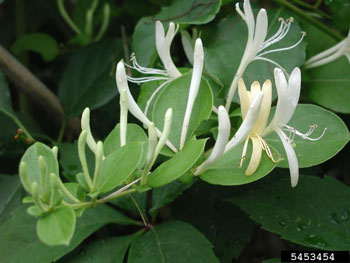 Japanese honeysuckle, Leslie J. Mehrhoff, University of Connecticut, Bugwood.org
Japanese honeysuckle, Leslie J. Mehrhoff, University of Connecticut, Bugwood.org
The Maine Natural Areas Program (MNAP) provides outreach and education services to help spread the word about invasive plants in Maine. MNAP has worked in conjunction with the Maine Department of Environmental Protection on a rapid assessment aimed at collecting baseline information about aquatic plant species and substrate types commonly found in Maine lakes. MNAP also produced the Invasive Plant Survey Atlas of Maine in 2002 which shows the distribution of many invasive plant species known from Maine.
Recorded Presentations
- 5/21/2020. Two webinars by Nancy Olmstead for UMaine Cooperative Extension.
- Invasive Plant Ecology and Identification. Invasive Plants can over-run wildlife habitat, strangle trees, and change soil microbe communities in ways that harm forests and other natural areas. You can help by learning to recognize these plants. Come learn: what is an invasive plant, and why are invasive plants harmful? Where do they come from, and how do they spread? How do I recognize the top invasive plants in Maine?
- Invasive Plant Management. Perhaps you already know how to recognize invasive plants and why they are harmful. What can we do about invasive plants? This presentation will cover key steps in managing invasive plants such as assessment, prioritization, control, disposal, and monitoring. There are many things you can do to reduce the impacts and spread of invasive plants.
- 12/1/2020. Webinar about Invasive Woody Plant Management with Nancy Olmstead for EPA Center Integrated Pest Management. Encroachment of woody vegetation threatens the biology and ecology of many types of ecosystems. The loss of natural foragers, fires, human-caused disturbances, and the introduction of non-native plants combine to impact native vegetation and associated wildlife. Removing invasive woody species improves the function of local ecosystems and opens the landscape to provide more suitable habitat for birds and other wildlife. This two-part series is a continuation of EPA’s tree IPM webinars and will focus on managing invasive woody plants such as tree of heaven, buckthorn, and Japanese knotweed. Attendees will learn the IPM practices used to provide cost-effective management of these woody invasives that include mechanical removal (cutting and shredding), herbicide treatments, fire, and biological controls. Learn how to identify these species and to develop IPM-based strategies for their prevention and control in your region.
- 6/10/2020. Identification and Management of Invasive Plants, for mid-coast Maine land trust audience of staff, volunteers, landowners, and general public. In this online workshop, Nancy Olmstead, invasive plant biologist from the Maine Natural Areas Program, covers identification of some of the most common terrestrial invasive plant species in the Midcoast region and provides a brief overview of management options.
